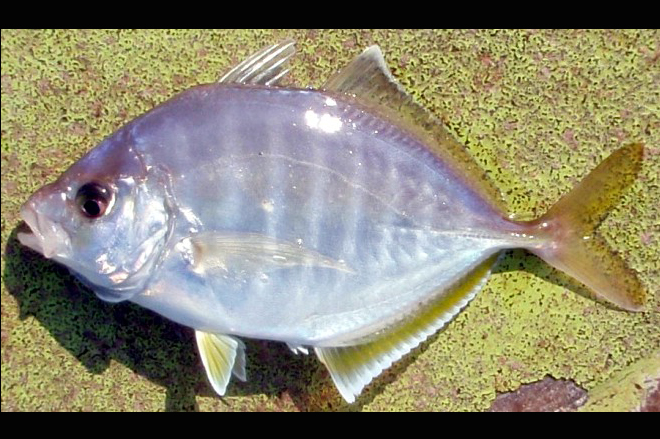Whitefin Trevally, Kaiwarinus equula (Temminck & Schlegel 1844)
Other Names: Horse Trevally

A Whitefin Trevally, Carangoides equula, trawled in Taiwan. Source: Kare Kare / Wikimedia Commons. License: CC BY Attribution-ShareAlike
Summary:
This species was previously known as Carangoides equula.
Cite this page as:
Bray, D.J. 2023, Kaiwarinus equula in Fishes of Australia, accessed 20 Apr 2024, https://fishesofaustralia.net.au/Home/species/4259
Whitefin Trevally, Kaiwarinus equula (Temminck & Schlegel 1844)
More Info
|
Distribution |
Houtman Abrolhos, Western Australia, around the tropical north to off Tathra, New South Wales. Elsewhere the species is widespread with a patchy distribution in the Indo-west-central Pacific. |
|
Fisheries |
Targeted by commercial and recreational fishers, and aquacultured in Japan. |
|
Species Citation |
Caranx equula Temminck & Schlegel 1844, Fauna Japonica Vol. 4(5–6): 111, pl. 60(1). Type locality: Ōmura Bay, Nagasaki, Nagasaki Prefecture, Kyūshū, Japan. |
|
Author |
Bray, D.J. 2023 |
|
Resources |
Whitefin Trevally, Kaiwarinus equula (Temminck & Schlegel 1844)
References
Allen, G.R. 1997. Marine Fishes of Tropical Australia and South-east Asia. Perth : Western Australian Museum 292 pp. 106 pls.
Allen, G.R. & Swainston, R. 1988. The Marine Fishes of North-Western Australia. A field guide for anglers and divers. Perth, WA : Western Australian Museum vi 201 pp., 70 pls.
Boeseman, M. 1947. Revision of the fishes collected by Burger and van Siebold in Japan. Zoologische Mededelingen (Leiden) 28: 1-242 pls 1-5
Gunn, J.S. 1990. A revision of selected genera of the family Carangidae (Pisces) from Australian waters. Records of the Australian Museum, Supplement 12: 1-77
Johnson, J.W. 2010. Fishes of the Moreton Bay Marine Park and adjacent continental shelf waters, Queensland, Australia. pp. 299-353 in Davie, P.J.F. & Phillips, J.A. Proceedings of the Thirteenth International Marine Biological Workshop, The Marine Fauna and Flora of Moreton Bay. Memoirs of the Queensland Museum 54(3)
Randall, J.E., Allen, G.R. & Steene, R. 1997. Fishes of the Great Barrier Reef and Coral Sea. Bathurst : Crawford House Press 557 pp. figs.
Sainsbury, K.J., Kailola, P.J. & Leyland, G.G. 1984. Continental Shelf Fishes of Northern and North-Western Australia. Canberra : Fisheries Information Service 375 pp. figs & pls.
Smith-Vaniz, W.F. 1984. Carangidae. pp. 1–12, 130 unnumbered pages, figs in Fischer, W. & Bianchi, G. (eds) FAO Species Identification Sheets for Fishery Purposes. Western Indian Ocean (Fishing Area 51). Rome : FAO Vol. 1.
Smith-Vaniz, W.F. 1999. Family Carangidae. pp. 2659-2756 in Carpenter, K.E. & Niem, T.H. (eds). The Living Marine Resources of the Western Central Pacific. FAO Species Identification Guide for Fisheries Purposes. Rome : FAO Vol. 4 pp. 2069-2790.
Smith-Vaniz, W.F. & Williams, I. 2016. Carangoides equula (errata version published in 2017). The IUCN Red List of Threatened Species 2016: e.T20429448A115372690. https://dx.doi.org/10.2305/IUCN.UK.2016-3.RLTS.T20429448A46664059.en. Accessed on 27 April 2023.
Temminck, C.J. & Schlegel, H. 1844. Pisces. pp. 73-112 pls 37-59, 60 (in part) in Siebold, P. Fr de (ed.) Fauna Japonica. Leyden : Apud Arnz & Socios Vol. 4(5–6).




